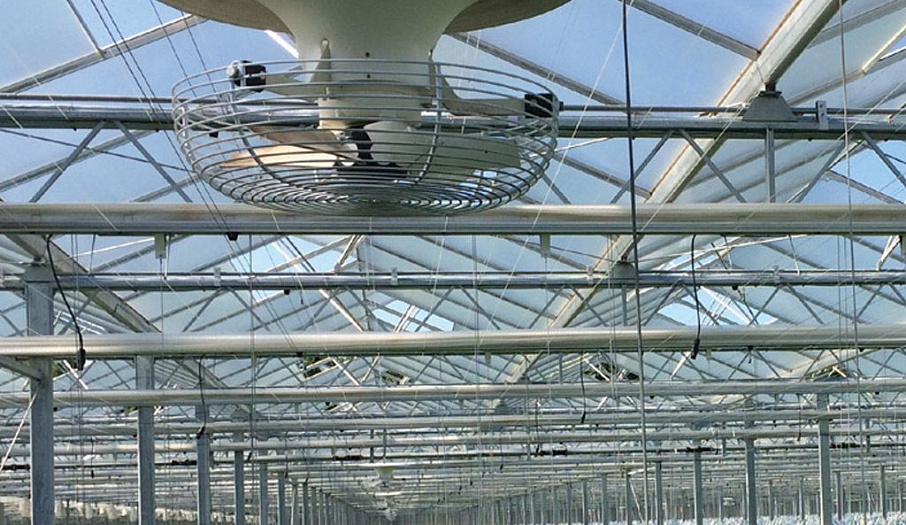Technology
Greenhouse microclimate system
Growing products in a closed ground allows for year-round production of fresh fruits and vegetables. Greenhouses protect them from external irritants such as unstable temperature, wind, precipitation, etc. However, despite this, there is a need to provide the structure with equipment to create a microclimate. The equipment is selected according to the requirements of the cultivation technology of a particular crop, the climate characteristics of the region, and the features of the structure. But it is important to ensure that the temperature in the greenhouse does not drop below 15°C. The cultivated crops react sharply to changes in conditions.
The main indicators that need to be provided in the greenhouse are:
Humidity
Temperature
Ventilation
Lighting
To create the right climate not only for shoots but also for roots and to ensure their proper nutrition, it is recommended to use drip irrigation systems. In this case, water is supplied uniformly in small quantities, providing nutrition to the crops and eliminating soil dryness. Irrigation systems are needed not only for more efficient product development but also for rational use of water resources.
Without organizing each of these systems, the greenhouse's operation will not be efficient. Only with the proper balance of all parameters is it possible to obtain a rich harvest and, consequently, income.
Natural ventilation system
The simplest and most accessible method of greenhouse ventilation is natural ventilation. The principle of this method is based on the temperature difference inside and outside. It requires windows, doors, and vents. Among the advantages, low air circulation speed can prevent drafts.
However, there are obvious disadvantages - this type of ventilation is suitable only for certain climatic zones, and often it is not enough.
The use of modern drive systems and control controllers allows for a fully autonomous, technological, and reliable implementation of this method to ensure the necessary cultivation conditions.
Shading system
The use of protective screens has become a norm in greenhouse cultivation. These systems allow for energy savings in winter and protection from excessive sunlight in summer.
Advantages:
Protection against excessive radiation in the summer period
Limiting heat loss in greenhouses
Work based on signals from light and temperature sensors/controllers
Ability to create the necessary length of the photoperiod for different crops
Roof ventilation
The level and timing of opening are controlled by the microclimate control system using a predefined technological program, as well as external and internal sensors. The drive, connected to a gear-wheel, transmits movement to the toothed racks, which in turn raise/lower ventilation windows.
Advantages:
Minimal energy consumption
Uniform opening throughout the volume/area
High reliability
Side ventilation
In tunnel greenhouses, side ventilation is the most effective ventilation method, and in combination with ridge ventilation, these methods are optimal for creating favorable conditions. Drive systems with a different operating principle are used. In this case, the side film/tent is wound onto a special roller, which is set in motion by the Ridder drive.
Advantages:
Maximum effect of natural ventilation
Low energy consumption
Best air exchange in the greenhouse
Simple and reliable control.
The main indicators that need to be provided in the greenhouse are:
Humidity
Temperature
Ventilation
Lighting
To create the right climate not only for shoots but also for roots and to ensure their proper nutrition, it is recommended to use drip irrigation systems. In this case, water is supplied uniformly in small quantities, providing nutrition to the crops and eliminating soil dryness. Irrigation systems are needed not only for more efficient product development but also for rational use of water resources.
Without organizing each of these systems, the greenhouse's operation will not be efficient. Only with the proper balance of all parameters is it possible to obtain a rich harvest and, consequently, income.
Natural ventilation system
The simplest and most accessible method of greenhouse ventilation is natural ventilation. The principle of this method is based on the temperature difference inside and outside. It requires windows, doors, and vents. Among the advantages, low air circulation speed can prevent drafts.
However, there are obvious disadvantages - this type of ventilation is suitable only for certain climatic zones, and often it is not enough.
The use of modern drive systems and control controllers allows for a fully autonomous, technological, and reliable implementation of this method to ensure the necessary cultivation conditions.
Shading system
The use of protective screens has become a norm in greenhouse cultivation. These systems allow for energy savings in winter and protection from excessive sunlight in summer.
Advantages:
Protection against excessive radiation in the summer period
Limiting heat loss in greenhouses
Work based on signals from light and temperature sensors/controllers
Ability to create the necessary length of the photoperiod for different crops
Roof ventilation
The level and timing of opening are controlled by the microclimate control system using a predefined technological program, as well as external and internal sensors. The drive, connected to a gear-wheel, transmits movement to the toothed racks, which in turn raise/lower ventilation windows.
Advantages:
Minimal energy consumption
Uniform opening throughout the volume/area
High reliability
Side ventilation
In tunnel greenhouses, side ventilation is the most effective ventilation method, and in combination with ridge ventilation, these methods are optimal for creating favorable conditions. Drive systems with a different operating principle are used. In this case, the side film/tent is wound onto a special roller, which is set in motion by the Ridder drive.
Advantages:
Maximum effect of natural ventilation
Low energy consumption
Best air exchange in the greenhouse
Simple and reliable control.

